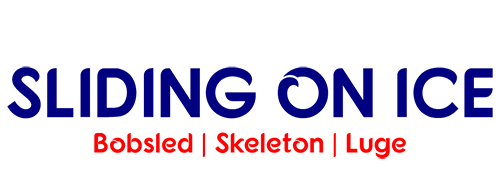(August 10, 2020) – For the 14th installment of Getting to Know… we venture up to Calgary to chat with Canada Skeleton’s Grace Dafoe. Grace has competed at the North American Cup, European Cup, and Intercontinental Cup levels and has won NAC gold in both Calgary (RIP) and Whistler. In Europe, she’s got a career-best finish of eighth, sliding on historic St. Moritz.
If there’s a slider you’d like to get to know, drop a note in the contact form above or on Twitter: @thekenchilds
Slider: Grace Dafoe
Team: Canada Skeleton
Home track: Calgary Whistler
Hometown: Calgary, CAN
Sponsors: Coalition Calgary, 360BrainBody, Vital Strength & Physiology, Classroom Champions
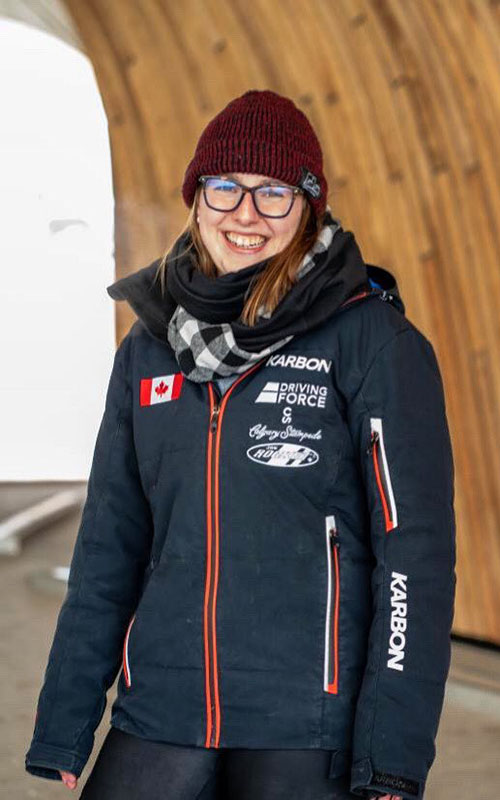
What is your favorite track and why?
I have thought so much about this. Every track has something that I love a portion about it or something about it and I’m removing Whistler from this because it’s a home track. This has changed a lot over the last couple of seasons, and now I think it’s Königssee. We have a history: It was my first time on European Cup and I crashed on half of my training runs. So THAT was fun, I got to meet the 6’5” doctor a bunch of times. I see him on TV now and I think “I saw him so many times!”
When I went back for Intercontinental Cup this past season something clicked and I thought “Oh, I understand when it’s going well it feels really great. When it’s going bad it feels REALLY bad.” I love the S curves, when you do them right they feel so so good. Kreisel is scary as all heck but when you do it right you feel a bunch of relief. The track has so many different personalities and it makes it fun. You have to adapt to put the S curves out of your head when you get out of them and are going to Kreisel and so on. So it’s a track that I really enjoy sliding on, plus the lake is really beautiful. We stay at this quaint little bed & breakfast with taxidermied animals up the stairwell. All in all the experience there is really great, and there’s wonderful views of the mountains. I think that’s one of the most beautiful start house views in the world.
Do you have a portion of the track that’s your favorite?
This is going to sound really weird, but when we were there for a week the past year and the first corner when you’re doing it right it feels really good. Kriesel has dumped me a few times that that’s not it, but the S curves feel like no other curve in the world.
On tour, what is your favorite track to visit?
Each one has its own little personality. There are some that aren’t as great. I’ve only been to Innsbruck once and I really liked that. But I think it’d be either Whistler or Königssee. Berchtesgaden and Salzburg are both nice. We went to the Christmas market in Salzburg and it was really nice. It’s just the proximity of the town itself, there’s a great training facility with a track we can get into in Salzburg, it’s really awesome. You can go in and have a real tourist day and it not be super time consuming. Whistler is so nice, I like to walk the village when I’m there. It’s like active recovery because I can just walk everywhere. It’s also kind of a second home now!
Prior to skeleton you did figure skating. Was there anything that translated from flat ice to hilly ice?
There’s actually a lot that translates from figure skating to skeleton. A lot of the jumping power helps a lot. You don’t realize how much power you need to jump off one leg with this skinny little blade to launch yourself into the air and rotate for three rotations and land and stop. So the core strength to stop that rotation makes me think a lot about skeleton and the strength you need for both pushing and driving the sled.
How did you get into skeleton in the first place?
There’s a lot of moving parts that led to starting skeleton. The 2010 Olympics in Vancouver was happening, and I was 17 at the time. I was obsessed! I’ve always been Olympics obsessed. I remember watching the 2002 Olympics in Salt Lake and the teacher rolled the cart into the classroom to watch the Canadian/USA ice hockey gold medal game, and I remember watching it and thinking “this is super cool!” I watched a bit of Torino, mostly for the figure skating, but Vancouver opened my eyes to how many sports there were in the winter sector. Around that same time my figure skating club had just moved up to WinSport to the brand new rink center up there. I kind of remember looking around and thinking “Wow!” You could see the ski jumps [RIP] and everything was there. It was the hub of Calgary, and we lived on the other side of the city so I didn’t really go there all that often so I found out there was so much up there.
I think those two things kind of planted the seed, then I graduated from high school and stayed in Calgary for University. WinSport had this “come try any sport” thing, there was a schedule and you could just show up. My dad’s friend is the father of John Fairbairn, and so I was aware of it. Then I get this email “Hey, here’s how you get into skeleton!” I went and Jon Montgomery was actually there! So I tried it from the tourist start and it was terrifying the first time. But I loved it, and thought I’d do a driving school. I talked to Alberta Skeleton and a few months later there I was. There’s not many sports you can get into at a high level as an 18 year old, it was either speed skating, track cycling, or skeleton. I sent an email to bobsled, but they didn’t get back to me because I’m 5’7”!
But I think if one thing had gone differently during that whole chain of events then I probably wouldn’t be in skeleton, but everything came together and it worked out.
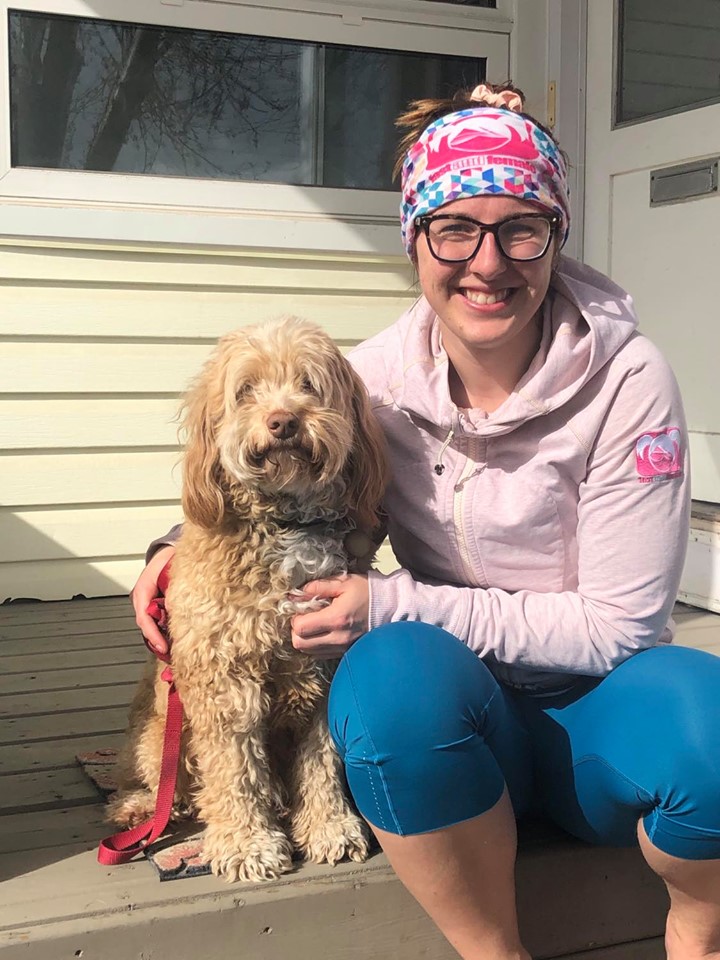
How did speed skating and track cycling go?
I did not try them! I hate bikes, and I don’t think I’ve biked in a few years. And speed skating was just too much cardio. I was done with cardio back then, now 60 meters is all the cardio I do.
Tell us about your dog.
Ivy is amazing! It’s super easy to remember exactly how long I’ve been sliding for, we got her the week before my sliding school in Calgary! I got her when I decided to not move across the country, I was living with my mom and the deal was when I moved out Ivy was coming with me. I moved out four years ago, and my mom said “here’s your dog!” She is everything and more to me, she’s amazing. I FaceTime her and my boyfriend hates it sometimes because I’ll ask him if we can FaceTime and I spend the whole time wanting to look at the dog. But now if I say “Hey Ivy” she turns her head at the camera and she knows. I ask her if she’s a good girl and she looks right into the camera! She does a good job now of knowing when I’m leaving, when the suitcases come out she’s just kind of like “okay, whatever”. When I came home from Europe, I was gone for three weeks and she whimpered and cried, but when I came home she legitimately sprained her tail from the happiness. I brought her to the vet and they said she’d sprained her tail from wagging! She’s basically an “emotional support animal” because no matter what happens I can come home and there she is. Throughout my whole sliding career she’s been there through it all: Making my first races, getting cut from teams, making the national team, it’s been an adventure. She’s a very good girl.
In the NAC/EC/ICC tours you have a lot of back-to-back race days. How does your preparation change from race to race on those weekends?
It’s definitely similar concepts. The second day just feels like such a grind sometimes. But sometimes I push faster on the second day though. I feel like the first day potentiates me a little bit better and sometimes I push better on that second race. Fingers crossed you don’t get your sled entirely torn apart at sled check after the first day. I’m all about sled check, but if you have to put your entirely back together it can double the amount of time to prepare for the second day. Of course that’s a “first world problem”, because that usually means you’ve placed well and one of the randoms. So hopefully the second day is a little less race prep.
So we usually race in the morning, then I go home, sit for 30 minutes and just decompress. Then you think “I have to go eat or get my race prep done”. There’s no video that night usually which is different than the first night. The first night you still have a team meeting, video, and it’s kind of a long day. You’ve got a track walk, race prep and all that. We did one ICC that was only one day and it was kind of weird to not have a second day. You kind of hope to learn from that first day, it’s like having more training runs. I guess it’s a difference between development tours and World Cups. Even ICC is prepping you for that World Cup kind of atmosphere. You feel like “I’m at a track that I don’t know that well, I just need more run volume.” And run volume at your full push compared to your training push is important. So I go in the night before the first night and think “four more runs…” then after the first race hopefully you’re healthy and it’s “just two more runs.” After that first run on the second day no matter what happened that week you’re either happy or sad to have this last run. Sad if it’s been going well, but happy if it’s been a tough week, like “let’s just get this over and get out of town!” I’ve definitely felt both of those. There’s just something about that second day to have two more runs to just lay it all out there, especially if you’re going into a break or a travel day, you know you can give it all you got. That first race day you both need to go fast but also know you have to race the next day so you may not always lay it entirely all out there and get injured then not be okay.
If you weren’t sliding what would you be doing with your life right now?
It’s actually really funny, I almost left Calgary to go to college. I was going to go to school out on the east coast and for a multitude of reasons I ended up staying out here. On a whim I applied to Mount Royal University here in Calgary and I got in which was nice. I knew I wanted to go into health and physical education. That’s the reason I didn’t go across the country to school, I was going to get into environmental sustainability, which is also a small passion of mine! But I kind of realized that wasn’t what I wanted to do with the rest of my life. The health and physical education program turned from a two year program to a four year program right when I was in the middle of it so I didn’t need to transfer to the bigger university here in Calgary to complete my degree which was great because I like the smaller school setting and smaller class sizes and everything. I started my skeleton career right after that first year of school.
I just think that I wouldn’t be the person I am without skeleton, it literally changed my life. I was ready to get a 9-5 job when I was out of school, but I still felt like there was an athlete side of me there. And I wasn’t always that competitive in figure skating so I don’t know where I got this idea that I could be a high performance athlete because I was a “middle performance athlete” as a skater. When I go to talk to schools I tell them how I was a mediocre figure skater turned into a national team skeleton athlete. It’s a long story!
I’ve met so many awesome people, and not just from skeleton but from where I trained before when I first started. There was national team rugby team athletes there for instance. I learned that how to give back to the community some from seeing these athletes in motion. I thought I wanted to coach a little bit more in my life but I’ve found myself working more with my community trying to give back, working with nonprofits and stuff like that. I’m with Classroom Champions full time, I never thought I’d be doing that either.
I’m sure I’d be happy doing whatever I’d be doing, but I wouldn’t be as fulfilled, I’m doing so much more about myself with confidence and what it takes to reach a goal. It took me eight years to make a national team, when I finally did it it it felt really sweet. It took a ton of blood, sweat, tears, getting bounced from the team, coming back. My grandmother has always said “what will be, will be” and you form a path but then you travel that path.
You mentioned your work with Classroom Champions, have you talked with Steve Mesler much about his journey?
I interned as an athlete with them a couple of seasons ago. I wasn’t selected to race as much on the development team and I was looking for something for some job experience. I wanted to be an athlete-mentor where you make the videos and everything and they told me I wasn’t quite the caliber of athlete they were looking for yet. But they told me they thought I could contribute in a different way and I ended up interning. A lot of that year was just getting to know Steve and hearing his stories and hearing about how he’s turned into this super successful co-founder of this amazing nonprofit. I say that our company has a high performance mindset because most of us are either current or former athletes and it’s definitely trickled down there.
He’s told me stories about them leading up to the games and their mentality for that and the moment he decided to try bobsled and everything. I think it’s just cool to not only have a mentor in my career but a mentor who also understands what the heck I’m going through. Also that they say “hey, it’s cool if you work from Winterberg for two week
s just be online!” It’s just really cool to be at a company with the same athlete mindset; we’re all go-getters who want to change the world and get things done now. It’s really exciting and gives me the same excitement that sport does. It’s cool to have someone like Steve be happy to mentor me in whatever way and answer whatever questions I may have about life or making a career or connections. He’s the guy who’s got it all and he’s just a super awesome human.
In the summertime when you’re not training what do you do with your free time?
Family and friends is number one. You miss a lot of stuff on the road and it’s really hard to have those weekends away. I was in Whistler FaceTiming the family during Thanksgiving, and while that’s really nice it’s not the same. So while you can’t make that time up, spending more quality time being around them in person is number one and that’s kind of what “refills the cup” for me. We have a lot of small craft breweries around here, so I like to go to those and do beer flights with my boyfriend. We live quite central in Calgary, so we can walk a lot of places which is great. Really, just food, wine, coffee, beer, all of that (but of course in moderation). I’m a huge sports fan too, so when I’m home I’ll turn on hockey, alpine skiing, World Cups, and other Olympic sports. CBC has “Road to the Olympics” see what other athletes are doing on their way to the Olympics. As an athlete yourself when you’re trying to advocate others to tune into your sport, you want to go the other way and tune into those other sports too. I don’t only want to know who they are every four years, I want to know the summer Olympians too and who they are and their stories. I would want people to do the same for me.
So far, what has been your favorite skeleton memory?
Oh man! I feel like I’m starting to get old in terms of sport years because there’s a lot of different ones that could be the answer here. But the one that I think of is my first competitive season. I’d been sliding with Alberta Skeleton for a couple of years just learning how to slide and kind of seeing the Calgary World Cup race and thinking about how cool that was. I went to all of the races and saw all of these awesome people. It was just super amazing, it’s definitely not the same as watching on TV, being there is so different. Then that season after the Sochi Olympic season there was a lot of retirements and I was told maybe three weeks before “hey, we have open North American Cup spots, we have provincial spots and you can go race on NAC”. Park City was my first international race and I remember waking up and thinking “I get to represent Canada” and I never had gotten to do that in my figure skating career or even had thought about it. You think about that then it’s, ICC, then it’s World Cup, then it’s World Champs, and you’re always thinking about the next thing. But to reflect on how cool that moment was. I won my first race in Calgary that January and I wasn’t in first after the first race. Sitting at the finish, I wasn’t in first place after the first run. But hearing that I’d won on my home track in Calgary was incredible. I still have the newspaper article about it even, and just having that, it’s just something that’ll stick with me forever.
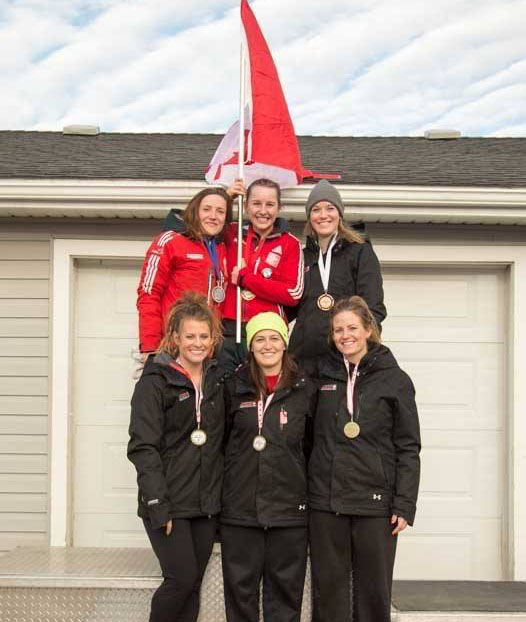
There are a lot of other great moments that will stick with me: Winning in Whistler, making the national team, etc. But I don’t think I wouldn’t have stuck around much longer had that season not happened because it’s what hooked me in to what sliding really is. I went on to the NAC circuit and we were really small that season and I got to know so many people. I got to know Morgan Tracey, Sam Culiver, Lauren Salter, I got to know them in part because most of us ran all of the races. There wasn’t as much “in-and-out” as there is now and just getting to know all of these awesome people and thinking about how cool of a group it was. I think that was a defining moment to me about how cool it is about how to represent your country. Even now when I hear the national anthem I think about standing on the Calgary finish dock, and they actually let us hold the flags that time, and hearing the national anthem. When I’m at a hockey game and we sing the national anthem I think about that moment.
On the other side of that, what’s been your hardest memory?
There are a couple for sure. I won a race in November of 2017 then was not chosen for the rest of the races of that season because of poor testing results, and that was really hard just because I’d had a really great year on the year before. I’d raced in European Cup, then rolled my ankle and then three weeks later was in a car accident and hired car accident lawyers to get the case solved. I had whiplash, not awful whiplash but definitely bad enough whiplash. So that offseason was really bad and that set the tone for testing. So I didn’t test well and a lot of questions were asked about my commitment and I thought “I swear I just had a bad offseason”. But I think it was a defining moment as well because I spent two years trying to rehab because I missed that summer and trying to get to full health. It really opened my eyes that I wasn’t 18 anymore and I really had to tighten down nutrition and recovery. I was with a newer strength coach than who I’d been with before because Morgan Alexander had moved to Bobsleigh Canada. So I was passed over to my other strength coach.
Secondly, last year was really hard. My grandmother was really sick all of last season, and she passed away the day I got to Whistler for selections. I had said my goodbyes and we knew I was going to be gone for two weeks and she wasn’t going to make it those two weeks. I made it a point to see her every day or so. But getting to Whistler, I was in the best shape of my life and was pushing really well, and then just feeling like I was a ghost for the two weeks of selections. I would finish a sliding session and felt like I wasn’t mentally there. I slid fine, but it wasn’t like I’d made any headway learning Whistler. I didn’t really feel like I’d earned my national team selection because I just didn’t really feel like I was there. She would watch my races whenever they’d stream and everything, and it was just super hard being away from home for that, then coming home from the season and she wasn’t there. Kind of being away you can ignore it, but coming home was hard. Do I wish I could have skipped selections and come home for that, would it have been the same result? I don’t know, and no one will ever know. It was definitely a defining moment and I always feel like I have a guardian angel with me when I’m sliding. It’s funny, when I told her I was going to start taking sliding school she said “can’t you just take up curling or something instead?” But then she grew to love it. I raced in St. Moritz and they live-streamed it and she woke up at 3:00 AM to watch the races at the age of 84, pulling up the iPad and watching my race!
When you get done with your season what do you do between the end of that and the start of off-season training?
Normally I do a lot of events and speaking things. I spoke at a high school for International Women’s Day which is super cool. They do an all-girls day where the girls can go see all of these speakers and there’s these small panels. I do as much with KidSport Calgary as I can like most of the awesome sliders in Calgary do. We do lots of events, and summers are usually big fundraising things for them. KidSport raises money for kids in the area to pay their registration fees for sports. So we as ambassadors go out to events. I do stuff with Fast & Female as well. It’s just nice after six months of time spent kind of head-down with testing, camps, and racing to go out and go speak and teach people about what I do.
I also use a lot of that time to do prehab and rehab mobility stuff done. Not even in a gym always, this year obviously I did it at home, but really it’s a time to let both my body and mind rest. This was probably the most intense season I’ve had, so normally I’d sort of jump into things where this year I was like “ooooh, now I see why people take some time off.” It’s just a nice time to rejuvenate and there’s no guilt associated with having a few extra snacks or a glass of wine or whatever. In the weeks leading up to testing you always are eating the heathiest you’ve ever eaten all offseason. I’m also not as genetically gifted as some of the other athletes so I need to check all of the boxes and make sure everything is fine. So the time off is when I can have cheesecake, maybe have a glass of wine and stay up late, stuff like that. It’s just important to take some of that time to do things you don’t normally get to do and relax. This year was great because I’d planned to take a little time off and then with COVID we couldn’t, but I didn’t realize how tired I was until I’d had some time at home to rest.
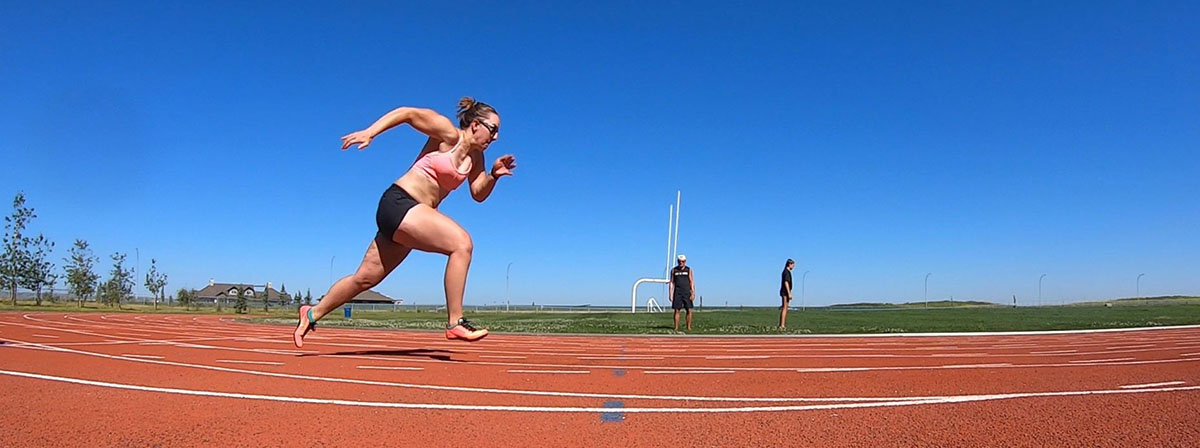
Guest question (Carlo Valdes – USA Bobsled): How have you been staying in shape for skeleton during all of the COVID lockdown?
I was running in the snow in March. They had kind of shuttered the track but not actually closed it down. There was a sign saying not to go there but there was nobody on the track most days so I figured “I’m going to run on the track”. After that, lots of Zoom training with my coach for sure. I was very lucky that the last couple weeks before the pandemic went into full swing I went and got a few things. I had mostly bands and stuff for prehab that we travel with, but I grabbed a couple dumbbells and kettlebells off and sent my coaches a list of what I had and the space I have and they gave me a lot of useful stuff. We were still able to get stuff in, lots of video with my strength coaches making sure that I was doing stuff right. I’d wake up to lots of video and diagrams of my hips going a certain way with lines drawn, trying to do the best we can. You just had to rely on what your coaches taught you about your form. I was very lucky that we quarantined fully for two weeks, and my dad has a home gym, he doesn’t have everything but he’s got a barbell and has weights and dumbbells and everything. So after two weeks of not going anywhere we decided it was safe that he was a part of a bubble because the reward was greater than the risk. So that’s what I ended up doing. Running was across a grass field up until a few weeks ago. We’ve only been training as a group for a month, it’s a small group with my sprint coach. It affected it, but it reminded me a lot of in-season because you’re in charge of a lot of your own stuff and how you feel. You have to be very aware of how you feel because you don’t have someone there to help you every step of the way. So carefully with lots of communication and coordination!
